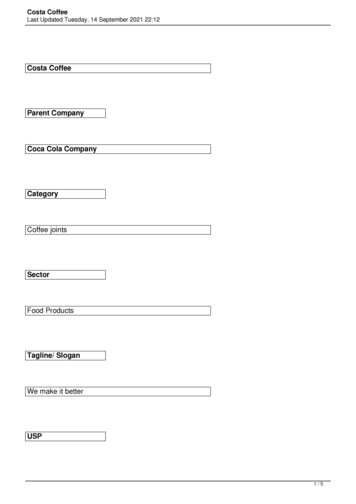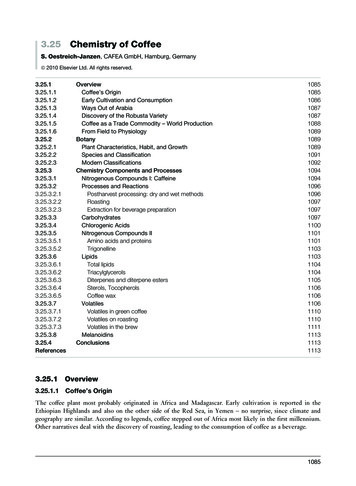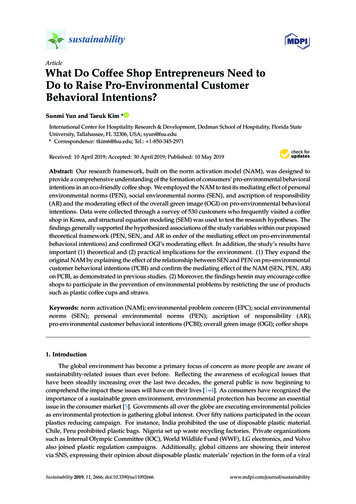
Transcription
sustainabilityArticleWhat Do Coffee Shop Entrepreneurs Need toDo to Raise Pro-Environmental CustomerBehavioral Intentions?Sunmi Yun and Taeuk Kim *International Center for Hospitality Research & Development, Dedman School of Hospitality, Florida StateUniversity, Tallahassee, FL 32306, USA; syun@fsu.edu* Correspondence: tkim6@fsu.edu; Tel.: 1-850-345-2971Received: 10 April 2019; Accepted: 30 April 2019; Published: 10 May 2019 Abstract: Our research framework, built on the norm activation model (NAM), was designed toprovide a comprehensive understanding of the formation of consumers’ pro-environmental behavioralintentions in an eco-friendly coffee shop. We employed the NAM to test its mediating effect of personalenvironmental norms (PEN), social environmental norms (SEN), and ascription of responsibility(AR) and the moderating effect of the overall green image (OGI) on pro-environmental behavioralintentions. Data were collected through a survey of 530 customers who frequently visited a coffeeshop in Korea, and structural equation modeling (SEM) was used to test the research hypotheses. Thefindings generally supported the hypothesized associations of the study variables within our proposedtheoretical framework (PEN, SEN, and AR in order of the mediating effect on pro-environmentalbehavioral intentions) and confirmed OGI’s moderating effect. In addition, the study’s results haveimportant (1) theoretical and (2) practical implications for the environment. (1) They expand theoriginal NAM by explaining the effect of the relationship between SEN and PEN on pro-environmentalcustomer behavioral intentions (PCBI) and confirm the mediating effect of the NAM (SEN, PEN, AR)on PCBI, as demonstrated in previous studies. (2) Moreover, the findings herein may encourage coffeeshops to participate in the prevention of environmental problems by restricting the use of productssuch as plastic coffee cups and straws.Keywords: norm activation (NAM); environmental problem concern (EPC); social environmentalnorms (SEN); personal environmental norms (PEN); ascription of responsibility (AR);pro-environmental customer behavioral intentions (PCBI); overall green image (OGI); coffee shops1. IntroductionThe global environment has become a primary focus of concern as more people are aware ofsustainability-related issues than ever before. Reflecting the awareness of ecological issues thathave been steadily increasing over the last two decades, the general public is now beginning tocomprehend the impact these issues will have on their lives [1–4]. As consumers have recognized theimportance of a sustainable green environment, environmental protection has become an essentialissue in the consumer market [5]. Governments all over the globe are executing environmental policiesas environmental protection is gathering global interest. Over fifty nations participated in the oceanplastics reducing campaign. For instance, India prohibited the use of disposable plastic material.Chile, Peru prohibited plastic bags. Nigeria set up waste recycling factories. Private organizationssuch as Internal Olympic Committee (IOC), World Wildlife Fund (WWF), LG electronics, and Volvoalso joined plastic regulation campaigns. Additionally, global citizens are showing their interestvia SNS, expressing their opinion about disposable plastic materials’ rejection in the form of a viralSustainability 2019, 11, 2666; ability
Sustainability 2019, 11, 26662 of 19campaign [6]. Environmentally-conscious consumers recognize that our society faces a severe crisisdue to environmental problems (e.g., climate change, water scarcity, and air pollution). Customerswith environmental concerns prefer to buy and use pro-environmental goods and services, even ifthey are less convenient than the alternatives [7,8]. Therefore, it is necessary to understand the needsof eco-friendly consumers and strive for pro-environmental management in the consumer marketby, for example, implementing environmentally-friendly technologies, initiating diverse eco-friendlyprograms, encouraging eco-friendly practices among customers and employees, modifying operationprocesses, and developing environmental policies and guidelines [2,7,9–11]. Notably, the global growthof the coffee shop industry has inevitably increased energy and resource consumption, from the amountof coffee that is harvested to the electricity needed to switch on the lights in the actual shops. Thisincreased consumption correlates with a rise in the amount of waste produced, including packagingmaterials and coffee grounds [12]. The issue of environmental sustainability in the coffee shop industryis frequently discussed in the mainstream media in terms of disposable waste, often focused on coffeecups and grounds [13,14]. Therefore, as coffee shops attempt to become environmentally friendlyin order to respond to consumers’ enhanced awareness, an increasing number of coffee shops areproactively changing their operations by focusing on more eco-friendly practices. For example,Starbucks is working to shrink its environmental footprint and meet its customers’ expectations byincreasing the use of recycled cups, reducing waste, and conserving energy/water [15]. Dunkin’ Donutsannounced its plan to eliminate all polystyrene foam cups in its global supply chain beginning inspring 2018, with a targeted completion date of 2020 [16]. Costa Coffee has put great effort into usingsustainable and recyclable products and equipment. For instance, the company’s paper cups are madeof a sustainable wood pulp material from northern European forests; the company does not use smartcoffee machines in order to help reduce carbon emissions, and it recycles all of its coffee sacks into theshops’ carpet underlay [16]. Despite this growing interest in pro-environmental behaviors, however,relatively little attention has been paid to the identification of the essential factors that influencepro-environmental customer behavioral intentions (PCBI) in environmentally-friendly coffee shops.PCBI can reduce severe environmental pollution and enable customers to improve their quality oflife in a clean environment and move toward a sustainable future [2,3,17–19]. PCBI also improvesbusiness in coffee shops by increasing customer revisits due to the higher demand for eco-friendlygoods and enhanced customer satisfaction and employee commitment [20]. Therefore, this study aimsto expand the research on PCBI and benefit both the environment and coffee shops’ ability to conductbusiness successfully.Previous studies have relied heavily on Ajzen’s [21] theory of planned behavior (TPB), Stern’s [22]value-belief-norm (VBN) theory, and Schwartz’s [23] norm activation model (NAM) as the mostimportant predictors of PCBI within the domain of environmental psychology [3,24–26]. Of these,the NAM is considered the most influential theory [3,24,27,28]. The NAM used in this study isbased on the NAM that researchers [3,27] developed by extending the VBN theory. The NAMimplies the decision-making process of activating norms for pro-social behavior [3,29]. Schwartz’s [23]NAM comprises three concepts: awareness of problems, ascription of responsibility (AR), andpersonal norms [3,22,23,30,31]. Although the NAM has been extensively used in PCBI [30], manyresearchers asserted the need to expand the original NAM to better explain individuals’ eco-friendlyintentions/behaviors [1,3,12,22,32–35]. In this study, the critical variable of the existing NAM is personalnorms. In Schwartz’s [23] study, personal norms are defined as “internalized rules of conduct thatare socially learned [and that] vary among individuals within the same society and direct behaviorin a particular situation”. Hence, personal norms are behaviors that appear differently dependingon individual tendencies and situations based on behaviors learned in society. Social norms affectindividuals, and then personal norms appear. Therefore, unlike the previous studies mentioned above,social environmental norms (SEN) are applied to the NAM, and social norms influence personalnorms and identify relationships with PCBI. Besides, previous studies on marketing and consumerbehavior have indicated that the overall image of a firm plays a critical role in customers’ behavioral
Sustainability 2019, 11, 26663 of 19intentions [36]. References [5,37,38] found that the higher the overall green image (OGI), the morepeople behave in an eco-friendly manner.To fill the existing research gaps, this study’s purpose is to develop a theoretical framework thatclearly explains PCBI in the environmentally-responsible coffee shop business, which has not yetbeen well documented. Moreover, we want to use customers’ environmental awareness as a basis formarketing to improve the coffee shop business by identifying the role of personal and social norms toexplain PCBI. Specifically, we aim to (1) broaden the NAM by incorporating the VBN framework andnormative process; (2) test the mediating impact of personal environmental norms (PEN, SEN, andAR); (3) deepen the NAM by considering the moderating impact of OGI; (4) identify the adequacyof the proposed model by conducting a model comparison; and (5) examine the relative importanceamong constructs in building intentions in the model.2. Conceptual Framework2.1. Environmental Problem ConcernProtecting the environment is paramount, and increasing concern about environmental protectionmay facilitate proper discussion about this issue. Thus, various studies have been conducted todefine the true nature of environmental concern and find its precise measurement methodology [35].Environmental problem concern (EPC) can be classified as a user-defined term. However, it normallyrefers to “awareness about humans’ capability to damage nature”. EPC can induce people to protectnature through three phases: seeing, feeling, and acting [39]. Mostafa [40] insisted that environmentalconcern can positively influence consumers’ intent to choose eco-friendly products. Evidence is offeredin the results of numerous studies aimed at shedding light on the relationship between environmentalconcern and pro-environmental intentions/behaviors [41,42].2.2. Norm Activation ModelNorm activation model (NAM) can be defined as “the standard of value judgment that a personshould follow when that person thinks and acts”. Amendments to people’s thoughts and behaviorsare made based on two types of norms: personal norms function from within and social normsthat are constructed in the surrounding society [43]. In 1977, Schwartz developed the NAM in thecontext of altruistic behavior. The model was designed to investigate the true nature of altruisticbehavior and to examine people’s pro-environmental behaviors and intentions [34] in order to explainmoral norm/pro-environmental action transfer [23]. Hopper and Nielsen [44] applied the NAM torecycling behavior, arguing that recycling should be interpreted as an altruistic behavior derivedfrom norms. The researchers argued that recycling behavior could be described as altruistic behaviorsince sorting/moving recyclable goods does not bring anything to oneself but only benefits futuresociety [44].The NAM has played a critical role in research on pro-social intentions, and it contains threecardinal variables: environmental problem concern (EPC), personal environmental norms (PEN),and ascription of responsibility (AR) [23,45]. Specifically, PEN is the NAM’s core element, describedas a “moral obligation to perform or refrain from specific actions” [46]. PEN works as an index ofpro-social behavior. EPC can be defined as “whether someone is aware of the negative consequencesfor others or for other things one values when not acting pro-socially” [45]. AR refers to “feelings ofresponsibility for the negative consequences of not acting pro-socially” [45]. For example, wastingelectricity may lead to a number of negative consequences. However, people who have EPC maydevelop AR to feel joint responsibility for its negative consequences. Inversely, the development of ARis difficult if EPC is not yet developed. Studies have found that EPC positively affects the developmentof AR [3,34]. According to studies performed using empirical methods, EPC, AR, and PEN play anessential role in individuals’ environmental intentions/behaviors [3,28,45,47–49]. Additionally, DeGroot and Steg [41] found that the cooperation between EPC and AR positively affected people’s
Sustainability 2019, 11, 26664 of 19acceptance of several energy policies. Moreover, Guagnano [50] reported that the cooperation betweenEPC and AR leads people to buy recycled paper products. From this perspective, we can suggest thatthe cooperation of EPC and AR may boost people’s AR for energy saving and develop further researchon the relationship between EPC and AR. According to Han’s study, evidence has also been producedthrough the empirical method, given the factors suggesting that EPC can affect AR, which can influencePEN to promote pro-environmental customer behavioral intentions (PCBI) [3]. Continuing the researchstream on the relationships among variables within the norm activation model framework, this studyproposes that EPC influences AR and PEN and that AR, in turn, affects PEN and PCBI.Hypothesis 1 (H1). Environmental problem concern is positively related to ascription of responsibility.Hypothesis 2 (H2). Environmental problem concern is positively related to personal environmental norm.Hypothesis 3 (H3). Ascription of responsibility is positively related to personal environmental norm.Hypothesis 4 (H4).behavioral intentions.Ascription of responsibility is positively related to pro-environmental customer2.3. Relationships among Environmental Problem Concern, Ascription of Responsibility, PersonalEnvironmental Norms, and Pro-Environmental Customer Behavioral IntentionsEnvironmental problem concern (EPC) refers to a sense of “knowing of the impact of humanbehavior on the environment” [50]. Since many environmental problems are slow-paced, complex,and indirectly related to individuals’ lives, a cognitive limitation occurs that makes it difficultfor people to recognize these problems. People’s indifference to and emotional reactions againstenvironmental problems work as emotional limitations [51]. Studies have found that the solutionto this is related to the positive effect of pro-environmental behaviors/intentions on EPC [52]. Forinstance, people with increased EPC prefer to purchase eco-friendly products or organic foods andtend to participate in recycling programs [53]. Some people stop using hairspray after learning thatchlorofluorocarbon damages the ozone. In association with the eco-friendly hotel management system,Chan and Hawkins [54] indicated that increased EPC and understanding of the system might lead toeco-friendly acts.A belief that environmental problems will threaten individual values can activatepro-environmental actions derived from personal environmental norm (PEN). In this case, PENcreates a general predisposition that influences all kinds of pro-environmental behaviors/intentions [55].For example, it is known that personal energy waste can create some negative consequences in thelong-term (e.g., power failure, environmental damage, and even global warming). In this case, EPCcan lead individuals who might be concerned to actively approach energy saving [56]. Prior researchalso reported that EPC has a significant influence on PEN. For instance, De Groot and Steg [45] foundthat respondents with high EPC had higher PEN than respondents with low EPC. Harland et al. [57]also found that high EPC can positively influence PEN in normal households, inducing the usage ofpublic transportation and water conservation. Similarly, high EPC can positively influence a hotelemployee’s PEN to save energy [56].In the norm activation model (NAM), EPC and ascription of responsibility (AR) are emphasizedas key factors that promote one’s personal obligation to engage in altruistic behavior. However,it is also true that AR was defined as a moderator between PEN and pro-environmentalbehaviors/intentions [46,58]. Scholars have found that the relationship between AR and PEN can bepositive [47]. For example, Bamberg et al. [58] showed that AR exerts a strong positive effect on PEN inthe context of car use. Han et al. [59] found a positive influence of AR on personal norms when travelersintended to stay at an environmentally responsible lodging. Stern’s [22] value-belief-norm (VAN) theorywas an attempt to link the NAM to the relationship between general values and pro-environmentalintentions/behaviors. The VAN is thereby also an integrative theory in itself and it assumes that
Sustainability 2019, 11, 26665 of 19pro-environmental intentions/behaviors can be directly determined by PEN, which is based on theNAM. In addition, Stern assumed that PEN has to be activated by AR and EPC. However, he alsoassumed EPC as a prerequisite of AR. According to the VBN theory, EPC is related to one’s generalecological worldview, which is measured by the new environmental paradigm [60]. In the proposedresearch model, PEN is activated by EPC and AR; moreover, EPC is posited to be an antecedent ofAR. People with AR are likely to feel responsible for their acts and be less likely to perform certainbehaviors [34]. A person’s intention to choose organic food is formulated by attitude, subjective norms,perceived behavioral control, and PEN [61,62]. Privileging organic food, in turn, promotes visitingrestaurants that feature organic menu items [34].Ultimately, PEN is activated by a certain level of EPC and people’s feeling of responsibility toalleviate the problem. When people understand the severity of an environmental problem, they aremore likely to undertake pro-environmental behavior [29]. For instance, people who are aware of therelationship between car usage and air pollution develop a sense of responsibility for alleviating airpollution, which leads them to reduce their car use [63]. Likewise, the NAM has been successfullyused to explain many kinds of pro-environmental behaviors, such as willingness to choose organicfood [64], intentions to revisit an eco-cruise [3,7], intentions to reduce energy use [59,65], and recyclingbehaviors [44,66–68]. According to Schwartz [23], behaviors reflect a person’s internalized valuesystem, and certain behaviors are performed when the relevant values and norms are about to beactivated. The NAM posits that people with EPC and AR for their activities are more likely to displayaltruistic behavior. When EPC and AR are present, people tend to act in ways that benefit others [69].Accordingly, we hypothesize:Hypothesis 5 (H5). Personal environmental norm is positively related to pro-environmental customerbehavioral intentions.2.4. Relationships among Environmental Problem Concern, Ascription of Responsibility, Social EnvironmentalNorms, and Pro-Environmental Customer Behavioral IntentionsEnvironmental problem concern (EPC) is a concept interest in environmental problems and/orconsequences [70]. Social environmental norm (SEN) can be compared to ethos, an air that inducespeople to have certain environmental problem concern (EPC). SEN is mentioned as an essential conceptthat helps explain individuals’ pro-environmental customer behavioral intentions (PCBI) [2,3,9,67,69,70].Moreover, in the examination of environmentally-friendly tourism behaviors, SEN has been used asan index of individual behavior [32,47,68–75]. The norm activation model (NAM) proposes that SENcan influence an individual’s actual behaviors through its influence on EPC [23]. In conjunction withself-concept, personal environmental norm (PEN) is expressed as a moral obligation to perform acertain behavior [23,76]. It can be interpreted as “a longing to do certain acts” and a behavior motivatedby a will to act according to one’s values [77]. In this case, SEN promotes a compulsion derived fromsociety’s current ethos to engage in certain acts, like environmental protection. For example, a tidy andorganized space creates an ethos in itself that encourages people to keep that place unsoiled. The roleof injunctive social norms is to suggest to people that they must follow specific social rules or therewould be a sanction [78]. A person who visits a tourist site may avoid littering for these reasons.Experimental studies have shown that SEN can have powerful effects on willingness to engage inpro-environmental behavior [43,79], and a significant relationship between SEN and PEN and theirimpact on environmentally-friendly purchasing intentions have been demonstrated in the context ofhospitality [3]. According to the NAM, SEN and PEN are interrelated; SEN influences PEN to modifyindividuals’ actual behaviors [23]. On the other hand, personal norms are defined as individuals’ ownbeliefs linked to their self-concepts. The NAM suggests various ways to understand SEN’s effect onpro-environmental intentions/behaviors [30,78,80]. The NAM was widely used to shed light on “adecision-making process through which personal and social norms mediate the influences of generalvalues on altruistic and/or helping behavior” [46] in the context of pro-environmental behavior [41].
Sustainability 2019, 11, 26666 of 19However, ever since the potential of the NAM’s extensive use in the environmental domain wasuncovered [81], behaviors such as the burning of garden waste [60], recycling [44,49,67], and energyconservation [82] have been studied using the NAM.Most studies interpret the NAM using either a mediation model or a moderation model. Themediation model assumes that EPC influences PEN through ascription of responsibility (AR) [33,45].In the moderation model, PEN’s influence on behavior is moderated by EPC and AR. In this study, weinterpret the NAM as a mediation model, as De Groot and Steg [45] provided strong evidence of theNAM as a mediation model via five recent studies comparing the two models.Researchers proposing a mediation model assume that PEN and AR have indirect effects onintentions and behaviors via PEN [66,83,84]. More specifically, PEN is assumed to mediate therelationship between AR and pro-social intentions and behaviors, and AR is assumed to mediate therelationship between EPC and PEN. This interpretation of the NAM has been supported by severalstudies [45]. Stern et al. [85] showed that PEN can be predicted by the level of AR. It has also beenshown that PEN can be a significant predictor of several pro-environmental behaviors. The applicationof the NAM enabled the identification of PEN as a mediator of behaviors’ situational factors [29], andenvironmental studies found influential factors of pro-environmental behaviors. For instance, Viningand Ebreo [49] found that EPC influenced recycling behavior even when PEN’s central role was not yetidentified. Moreover, some researchers suggest that PEN mediates the relationship between all of theNAM’s independent variable components including EPC, AR, and PEN. In addition, SEN is generallybelieved to be an effective predictor of PEN and PCBI [2,3,7,10,47]. According to Kim et al. [86],SEN effectively mediates the relationship between green identity and customers’ purchase intentions.Ultimately, it can be assumed that EPC influences SEN while SEN affects PCBI and PEN within ourconceptual framework. Hence, the following hypotheses were formulated:Hypothesis 6 (H6). Environmental problem concern is positively related to social environmental norm.Hypothesis 7 (H7).behavioral intentions.Social environmental norm is positively related to pro-environmental customerHypothesis 8 (H8). Social environmental norm is positively related to personal environmental norm.Hypothesis 9 (H9). Ascription of responsibility, social environmental norm, and personal environmental normsignificantly mediate the relationship between environmental problem concern and pro-environmental customerbehavioral intentions.2.5. Moderating Effect of Overall Green ImageAccording to Martineau [87], “store image” is the reflection of a shopper’s awareness abouta store, partly based on function and partly based on its atmosphere made up of psychologicalattributes. Subsequent studies have focused on the relationship between store image and customers’perceptions. Moreover, brand image creates brand awareness, which prompts consumers to makepurchase decisions [88]. Ur and Ishaq [89] proved that store image has a significant moderatingeffect on the relationship between brand image and purchase intention. Furthermore, store imagebecame known as a manipulator of consumers’ price assessments, perceptions, satisfaction, andintentions/behaviors. Therefore, store image can be treated as a critical concept in consumer behaviorresearch [36]. In addition, Bloemer and De Ruyter [36] have insisted that store image is a firm’s mostimportant attribute, alluding to consumers’ core element of overall perceptions of a firm. Accordingto Keller [90], “firm image” is “a series of perceptions about a firm as reflected by its associations inconsumers’ memories”.Customers’ perceptions of a store’s overall image can be converted to overall green image(OGI) [36]. Wang et al. [37] evaluated whether customers perceived a restaurant’s green image as itsgreen practices. OGI, which refers to the tendency to perform eco-friendly practices, can be used in
Sustainability 2019, 11, 26667 of 19brand advertising since the consumers’ minds can personally link the green image with environmentalcommitments and concerns [91]. Customers in the hotel industry with OGI are more likely to engagein eco-friendly practices [38]. Similarly, a restaurant’s OGI can relate consumers’ perceptions of therestaurant with pro-environmental customer behavioral intentions (PCBI).In consumer behavior, scholars have stressed the role of image for firms and products.Jeong et al. [38] tested the impacts of eco-friendly practices on a cafe’s green image and its customers’attitudes. The results showed that a green image fostered positive customer attitudes toward the café,eventually affecting consumption decisions. Han [5] suggested that enhancing a hotel’s green imagecan manipulate customers’ pro-environmental intentions, which affects consumption decisions. Thus,this strategy can significantly benefit hoteliers in the green hotel industry. Based on these researchfindings, it can be assumed that the strength of the relationship between ascription of responsibility(AR), personal environmental norm (PEN), social environmental norm (SEN), and pro-environmentalcustomer behavioral intentions (PCBI) depends on the level of overall green image. Based on thediscussion of the relationship between SEN, PEN, AR, and PCBI, three hypotheses are proposedas follows:Hypothesis 10a (H10a). Overall green image has a significant moderating role in the relationship betweenascription of responsibility and pro-environmental customer behavioral intentions.Hypothesis 10b (H10b). Overall green image has a significant moderating role in the relationship betweenpersonal environmental norm and pro-environmental customer behavioral intentions.Hypothesis 10c (H10c). Overall green image has a significant moderating role in the relationship betweensocial environmental norm and pro-environmental customer behavioral intentions.3. Materials and Methods3.1. Measures and QuestionnaireThe study’s online questionnaire included two sections. The first part of the survey requesteddemographic information (e.g., gender, marital status, age, educational level, annual income level,purpose of visits, and number of visits). The second part of the conceptual model constructsenvironmental problem concern (EPC), ascription of responsibility (AR), personal environmental norm(PEN), social environmental norm (SEN), overall green image (OGI), and pro-environmental customerbehavioral intentions (PCBI). The measurement scales can be found in the literature [2,3,10,22,23,29–31,34]. Specifically, EPC featured three items (e.g., “I try not to buy from a brand of coffee shop thatstrongly pollutes”) adopted from Choi et al. [1]; AR featured four items (e.g., “I feel jointly responsiblefor the exhaustion of energy sources”) obtained from Steg and De Groot [31]; PEN featured threeitems (e.g., “I feel an obligation to visit environmentally responsible coffee shops rather than regularcoffee shops”) adopted from Berenguer [24]; SEN featured three items (e.g., “Most people who areimportant to me would believe that I visit an environmentally responsible coffee shop”) obtained fromHan et al. [5]; OGI featured three items (e.g., “My overall impression regarding a pro-environmentalcoffee shop is important”) adopted from Han, Hsu, and Lee [5]; and, finally, PCBI featured eight items(e.g., “To protect the environment, I would expend effort to visit an environmentally responsible coffeeshop rather than a general coffee shop in the future”) obtained from Han et al.[3]. The measurementitems used in this study are presented in the Appendix A. A seven-point Likert scale was used for allthe measurement items in this research, ranging from “Extremely disagree” (1) to “Extremely agree”(7). In sum, we used 24 items for the assessment of the six variables in this study.3.2. Data Collection and the SampleThe questionnaire was conducted with general coffee shop customers in Seoul, Republic of Koreavia an online, self-administered questionnaire between 4 and 24 February 2019. In order to reduce the
Sustainability 2019, 11, 26668 of 19common method bias (CMB) [92,93], procedural remedies were used in this study. First, in order toimprove scale items before participants received the questionnaire, we supplemented the ambiguousexpressions and questions under the guidance of five professors affiliated to Department of FoodserviceManagement from 21–24 January 2019. In addition, to reduce the CMB, the ques
International Center for Hospitality Research & Development, Dedman School of Hospitality, Florida State University, Tallahassee, FL 32306, USA; syun@fsu.edu * Correspondence: tkim6@fsu.edu; Tel.: 1-850-345-2971 Received: 10 April 2019; Accepted: 30 April 2019; Published: 10 May 2019


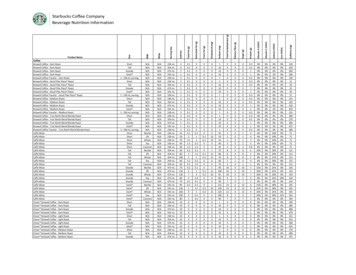

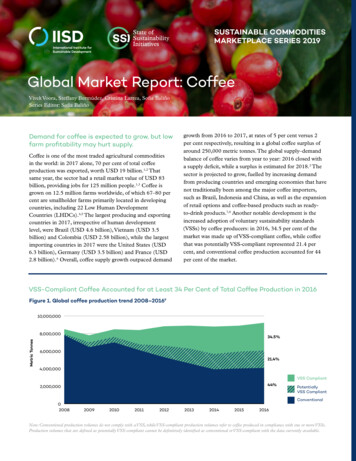

![[Ringle Material] 3rd wave coffee (Philz Coffee and Blue .](/img/22/2592b1ca.jpg)

